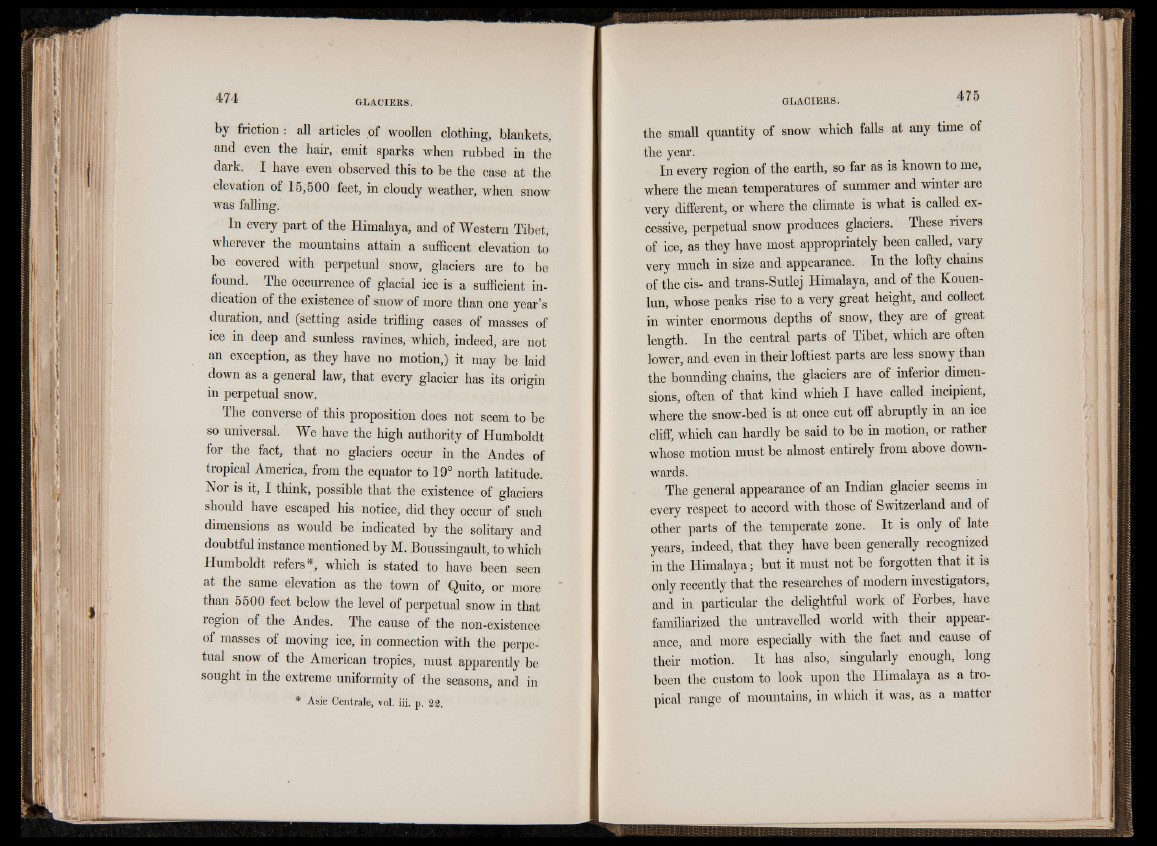
by friction : all articles of woollen clothing, blankets,
and even the hair, emit sparks when rubbed in the
dark. I have even observed this to be the case at the
elevation of 15,500 feet, in cloudy weather, when snow
was falling.
In every part of the Himalaya, and of Western Tibet,
wherever the mountains attain a sufficent elevation to
be covered with perpetual snow, glaciers are to be
found. The occurrence of glacial ice is a sufficient indication
of the existence of snow of more than one year’s
duration, and (setting aside trifling cases of masses of
ice in deep and sunless ravines, which, indeed, are not
an exception, as they have no motion,) it may be laid
down as a general law, that every glacier has its origin
in perpetual snow.
The converse of this proposition does not seem to be
so universal. We have the high authority of Humboldt
for the fact, that no glaciers occur in the Andes of
tropical America, from the equator to 19° north latitude.
Nor is it, I think, possible that the existence of glaciers
should have escaped his notice, did they occur of such
dimensions as would be indicated by the solitary and
doubtful instance mentioned by M. Boussingault, to which
Humboldt refers*, which is stated to have been seen
at the same elevation as the town of Quito, or more
than 5500 feet below the level of perpetual snow in that
region of the Andes. The cause of the non-existence
of masses of moving ice, in connection with the perpetual
snow of the American tropics, must apparently be
sought m the extreme uniformity of the seasons, and in
* Asie Centrale, vol. iii. p. 22.
the small quantity of snow which falls at any time of
the year.
In every region of the earth, so far as is known to me,
where the mean temperatures of summer and winter are
very different, or where the climate is what is called excessive,
perpetual snow produces glaciers. These rivers
of ice, as they have most appropriately been called, vary
very much in size and appearance. In the lofty chains
of the cis- and trans-Sutlej Himalaya, and of the Kouen-
lun, whose peaks rise to a very great height, and collect
in winter enormous depths of snow, they are of great
length. In the central parts of Tibet, which are often
lower, and even in their loftiest parts are less snowy than
the bounding chains, the glaciers are of inferior dimensions,
often of that kind which I have called incipient,
where the snow-bed is at once cut off abruptly in an ice
cliff, which can hardly be said to be in motion, or rather
whose motion must be almost entirely from above downwards.
The general appearance of an Indian glacier seems in
every respect to accord with those of Switzerland and of
other parts of the temperate zone. It is only of late
years, indeed, that they have been generally recognized
in the Himalaya; but it must not be forgotten that it is
only recently that the researches of modern investigators,
and in particular the delightful work of Forbes, have
familiarized the untravelled world with their appearance,
and more especially with the fact and cause of
their motion. It has also, singularly enough, long
been the custom to look upon the Himalaya as a tropical
range of mountains, in which it was, as a matter